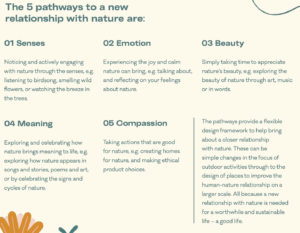How can ‘nature connectedness’ improve wellbeing for people and nature?
In our blog this week, Professor Miles Richardson talks about the Nature Connectedness Research Group, and the research that has informed the work of several leading nature conservation organisations as well as the 2021 Mental Health Awareness Week’s research report and policy briefing.
During the restrictions to control the coronavirus pandemic, the nation’s mental wellbeing suffered, and people turned to nature. At the same time, the natural world is also in crisis – the warming climate and loss of wildlife show that the relationship between people and the rest of nature is failing.
In association with The Mental Health Foundation (as well as with other organisations including the National Trust and the Wildlife Trusts) the Nature Connectedness Research Group has been applying its research to actively build new relationships with nature. We found that a closer connection with nature can boost the wellbeing of both people and the natural world – challenging current models of wellbeing, with important implications for policy.
The evidence – why our relationship with nature matters
‘Nature connectedness’ refers to the way we relate to and experience nature. A strong connection with nature means feeling a close relationship or an emotional attachment to our natural surroundings. It is grounded in scientific study and is measurable. Our research found:
- People’s nature connectedness, rather than contact with nature, predicts a sense that life is worthwhile that is nearly four times larger than the increase associated with higher socio-economic status.
- During the restrictions to control the pandemic, increases in noticing nature was linked to higher wellbeing than increases in visiting nature.
- Simply noticing ‘the good things in nature’ brings sustained benefits to mental wellbeing, with clinically significant improvements for people with common mental health problems.
- When measured alongside nature connection and noticing nature, time in nature uniquely explained just 1% of happiness, a worthwhile life, and higher wellbeing.
Wider research across 18 countries shows that in the UK we visit nature much less than people in other countries. Our connection to nature is also much lower than elsewhere. There’s a causal link between nature connectedness and pro-nature behaviours, so nature connectedness is an essential target to foster for increased wellbeing.
Actions – for a new relationship with nature
Forging a new relationship with nature can lead to happier and more fulfilled people and also a thriving environment. Places where people have higher engagement with green spaces foster more equal wellbeing. However, in order to build this relationship, we need policies that enable people to connect with nature.
Nature doesn’t have a ‘part-time’ role in wellbeing so we must go beyond occasional access and visits to nature, and engaging people through facts and figures. The research evidence tells us we can build a new relationship by creating an environment that fosters the ‘pathways to nature connectedness’:

This has a number of broad implications for policy. We need to actively:
- Foster a culture of connecting with nature – from an arts policy that celebrates nature, to nature connectedness being a standard metric for wellbeing.
- Use biodiversity to unite the wellbeing of people and nature by bringing nature recovery networks into urban areas for an abundance of wildlife to notice.
- Improve access for connection – moving beyond simple access to creating ‘habitats for connection’, providing meaningful engagement with nature on everyone’s doorstep.
- Design urban spaces around the pathways to nature connectedness, to prompt people to notice, engage and care for nature.
- Build a life-long relationship with nature – addressing the ‘teenage dip’ by bringing nature into secondary schools and ensuring adults understand the value of nature for keeping well.
Further details of Nature Connectedness Research Group’s work can be found on the University of Derby website and Miles’ personal blog: findingnature.org.uk and Twitter feed: @findingnature.
